|
|
|
Sort Order |
|
|
|
Items / Page
|
|
|
|
|
|
|
| Srl | Item |
| 1 |
ID:
187792
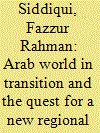

|
|
|
|
|
| Publication |
Chennai, Macmillan Publishers India Pvt Ltd, 2022.
|
| Description |
xii, 242p.hbk
|
| Standard Number |
9789354550713
|
|
|
|
|
|
|
|
|
|
|
|
Copies: C:1/I:0,R:0,Q:0
Circulation
| Accession# | Call# | Current Location | Status | Policy | Location |
| 060258 | 956/SID 060258 | Main | On Shelf | General | |
|
|
|
|
| 2 |
ID:
131895
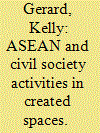

|
|
|
|
|
| Publication |
2014.
|
| Summary/Abstract |
The Association of Southeast Asian Nations (ASEAN) has recently made numerous commitments to engage civil society organizations (CSOs) in its governance practices. However, the opportunities created offer limited means for CSOs to contest policy as a result of strict controls over who can participate and the forms of participation permitted. Activists have consequently pursued their agendas outside of spaces sanctioned by ASEAN through 'created spaces,' such as conferences organized parallel to official summits. However, this form of political participation has limited potential to influence official processes because despite its independence, these activities are still structured in relation to ASEAN practices. The ineffectual nature of CSO advocacy despite ASEAN's people-orientated shift has been documented, however explanations for this trend remain limited. This article applies the modes of political participation framework that acknowledges the role of intergovernmental organizations in structuring spaces for civil society participation and, in doing so, shaping the contribution that CSOs can make. Through an examination of the regulations and practices that govern CSO participation in both ASEAN-sanctioned and independent spaces, it argues that spaces for CSO participation are structured to prevent CSOs from contesting policy, suggesting that ASEAN's shift to widen participation is directed towards legitimating its reform agenda. Hence, ASEAN's claim of becoming 'people oriented' must be considered in recognition of the limiting effect its engagement practices have on CSOs' ability to advance alternative agendas.
|
|
|
|
|
|
|
|
|
|
|
|
|
|
|
|
| 3 |
ID:
131848
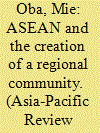

|
|
|
|
|
| Publication |
2014.
|
| Summary/Abstract |
After the ASEAN Concord II called for the building of an ASEAN Community in 2003, the creation of an ASEAN Community became a concrete part of the political agenda for the nations of Southeast Asia, and an ASEAN Community is scheduled to be created in 2015. However, it will all be for naught if the ASEAN Community that is established does not truly contribute to the stability and prosperity of the region. From this point of view, the article will attempt to evaluate the development of an ASEAN community concept and efforts to create it. To clarify the ideal of a true community, this article will take up Karl Deutsch's concept of "pluralistic security communities" and reconsider what a community requires. The article will state that the efforts to create an ASEAN Community should not be underestimated, and the blueprints for the creation of the ASEAN Community outline the formation of a true regional community. It will, however, conclude that in reality there exist factors within the ASEAN region that may shake the development of an ASEAN Community. It has to be said that the fostering of a sense of community at the level of ordinary people, as well as the creation of a community in which fundamental values and norms are shared, are distant propositions.
|
|
|
|
|
|
|
|
|
|
|
|
|
|
|
|
| 4 |
ID:
153241
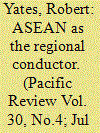

|
|
|
|
|
| Summary/Abstract |
This paper analyses ASEAN's prominence in regional order negotiation and management in Southeast Asia and the Asia-pacific through the lens of social role negotiation. It argues that ASEAN has negotiated legitimate social roles as the ‘primary manager’ in Southeast Asia and the ‘regional conductor’ of the Asia-Pacific order. It develops an English School-inspired role negotiation framework and applies it to three periods: 1954–1975 when ASEAN's ‘primary manager’ role emerged from negotiations with the USA; 1978–1991 when ASEAN's role was strengthened through negotiations with China during the Cambodian conflict; and 1991-present when ASEAN created and expanded the ‘regional conductor’ role. Negotiations during the Cold War established a division of labour where great powers provided security public goods but the great power function of diplomatic leadership was transferred to ASEAN. ASEAN's diplomatic leadership in Southeast Asia provided a foundation for creating its ‘regional conductor’ role after the Cold War. ASEAN's ability to sustain its roles depends on maintaining role bargains acceptable to the great powers, an increasingly difficult task due to great power rivalry in the South China Sea.
|
|
|
|
|
|
|
|
|
|
|
|
|
|
|
|
| 5 |
ID:
173186
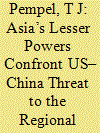

|
|
|
|
|
| Summary/Abstract |
Tensions between the United States and China have been on the rise under Xi Jinping and Donald Trump, challenging longstanding regional moves to peace and prosperity. In response, a number of less powerful East Asian states have taken steps toward deeper regional economic ties and multilateral institutions. This paper analyzes these competing tensions and their implications for the Asia-Pacific regional order.
|
|
|
|
|
|
|
|
|
|
|
|
|
|
|
|
| 6 |
ID:
151610
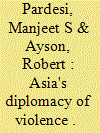

|
|
|
|
|
| Summary/Abstract |
Military coercion has already changed the Asia-Pacific region.
|
|
|
|
|
|
|
|
|
|
|
|
|
|
|
|
| 7 |
ID:
134019
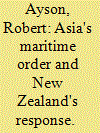

|
|
|
|
|
| Publication |
2014.
|
| Summary/Abstract |
Robert Ayson comments on the South China Sea. Asia's regional security and New Zealand foreign policy
as the powers jostle in a more competitive Asia-Pacific region, it may seem counter-intuitive to call for a clearer New Zealand position on the South China Sea disputes. But even as regional tensions grow, Wellington can stick up for its principles without joining a chorus of China criticism. Under the key government, New Zealand's alignment with the United States is becoming more pronounced through a series of small but cumulatively important steps. this makes it even more important for New Zealand's policy to be staked out clearly, including in written from accessible to the public discussion.
|
|
|
|
|
|
|
|
|
|
|
|
|
|
|
|
| 8 |
ID:
119073
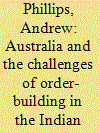

|
|
|
|
|
| Publication |
2013.
|
| Summary/Abstract |
This article considers the regional order-building challenges that Australia presently confronts in the Indian Ocean region (IOR). The author argues that while regional stability within the IOR constitutes an increasingly important Australian security interest, policy makers will struggle to translate the order-building strategies they have previously pursued in East Asia into an Indian Ocean context. In East Asia, Australia has historically pursued a 'dual track' order-building strategy centred on its participation in a US-dominated 'hub and spokes' alliance system alongside multilateral regional engagement. The absence of an equivalent alliance system or an established tradition of multilateral security diplomacy conversely precludes an extension of this strategy into the IOR. Growing tensions between the USA and China and between China and India, meanwhile, further complicate IOR security dynamics, while underscoring the urgent need for a more coherent approach to regional order-building. With these challenges in mind, the author concludes by proposing a range of bilateral, minilateral and multilateral initiatives that Australia should pursue to stimulate the emergence of a more cooperative IOR security environment.
|
|
|
|
|
|
|
|
|
|
|
|
|
|
|
|
| 9 |
ID:
160419
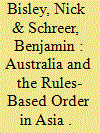

|
|
|
|
|
| Summary/Abstract |
In response to a more-contested Asia, Australia has placed the ‘rules-based order’ at the heart of its declaratory strategic policy. This move signals Australia’s commitment to this order, to its alliance with the United States, and to a more active strategic role in the region. However, a failure to match rhetoric with action risks undermining Australia’s strategic interests by emboldening China and reducing Australia’s value as an American ally.
|
|
|
|
|
|
|
|
|
|
|
|
|
|
|
|
| 10 |
ID:
126586


|
|
|
|
|
| Publication |
2013.
|
| Summary/Abstract |
Using the 'achievement index', a country's relative size of gross domestic product divided by its relative size of population, I argue that the high-achieving position of the West, as a structural distortion, has been a principal source of instability in the modern international system. Rather than being just unsatisfied great powers, large high achievers and stagnant low achievers engage in hegemonic and counter-hegemonic warfare, respectively. Both hierarchy and balancing systems are structurally more stable if they are 'natural' and less stable if they are 'unnatural', with being natural defined as an achievement index of 1. The rise of the rest constitutes a long-term trend back to nature, beginning to flatten the heretofore skewed international structure, which lessens one source of modern system-level instability. With a much larger share of world population, China cannot rise to the same relative height as the West that rose with a much smaller share of the population. China's rise is thus unlikely to repeat the past experience of the rising West.
|
|
|
|
|
|
|
|
|
|
|
|
|
|
|
|
| 11 |
ID:
131999
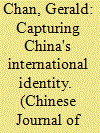

|
|
|
|
|
| Publication |
2014.
|
| Summary/Abstract |
What is China's international identity? How has it changed over time, especially since the reform and opening up of the country in the late 1970s? How does China see itself? And how do other countries see China? I argue that answers to these questions are instrumental to a proper understanding of Chinese foreign-policy behaviour, in ways more significant than we normally assume. To advance this argument, I choose to examine China's social interactions with the outside world to ascertain the evolution of its international identity/identities. I shall trace the domestic sources of China's external policies. In so doing, I hope this article will elucidate the 'debates' between social constructivism and realism as to their relative explanatory power with respect to the making of Chinese international identity. I also hope it will throw light on a possible alternative framework, known as social evolution, for studying China's international relations and its evolving identities.
|
|
|
|
|
|
|
|
|
|
|
|
|
|
|
|
| 12 |
ID:
159829
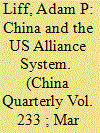

|
|
|
|
|
| Summary/Abstract |
In recent years, scholarship examining US and security allies’ responses to China's rapidly growing power and “assertive” policies towards its neighbours has proliferated. The English-language literature remains relatively one-sided, however. Crucial to understanding the complex forces driving strategic competition in the contemporary Asia-Pacific are comprehensive surveys of how Chinese views are evolving. This study draws extensively on Chinese sources to update existing scholarship, much of it two decades old, with a particular focus on recent Chinese reactions to major developments concerning the US-centred alliance system – a foundational element of the 65-year-old regional order. Beijing expresses deepening frustration towards, and even open opposition to, recent alliance strengthening, and instead champions alternative security architectures free of what it alleges to be “exclusive,” “zero-sum,” “Cold-war relic” US-centred alliances. Proposals for concrete pathways to operationalizing these abstract visions that take into account contemporary political and security realities (for example, North Korea), however, appear less forthcoming.
|
|
|
|
|
|
|
|
|
|
|
|
|
|
|
|
| 13 |
ID:
172123
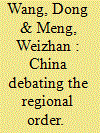

|
|
|
|
|
| Summary/Abstract |
This article examines China’s academic debates on the regional order in Asia since 2012, by surveying nine thematic issues. Those thematic issues are not exhaustive, yet they provide an overview of China’s intellectual landscape on the key issue of the regional order in Asia. This study shows that the United States (US) might have exaggerated China’s strategic intention. Rather than aiming to replace US hegemony with a Chinese-led Tianxia/tributary system in the region, Chinese scholars advocate mutual accommodation between China and the US.
|
|
|
|
|
|
|
|
|
|
|
|
|
|
|
|
| 14 |
ID:
126585
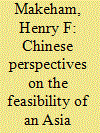

|
|
|
|
|
| Publication |
2013.
|
| Summary/Abstract |
The ongoing worries complicating China's rise are exacerbated by China's perceived double-bind dilemma: China is attacked as a threat to regional stability when it is active in the regional arena and damned as an irresponsible stakeholder when it is not. As an emerging global power China is naturally seeking to secure its ever-increasing interests abroad. Therefore, China's double-bind will intensify as China's foreign policy evolves from 'biding its time and hiding its capacities' to that of an increasingly proactive regional actor. The author argues that, in light of this likely transition in Chinese foreign policy conduct, the time is more pressing than ever before to mitigate anxieties and maximise the chances of China's positive-sum integration within the region. The argument correlates with the proposal by Australian Prime Minister Kevin Rudd in 2008 that the region begin contemplating the realisation of an Asia Pacific community (APc) concept, as a framework to rehabilitate the region's multilateral architectural mélange and implicitly reform the ASEAN Way-driven modus operandi with a more muscular APc Way. Such an outcome may be realised through streamlining the region's institutional alphabet soup and reforming the lacklustre ASEAN Way.
|
|
|
|
|
|
|
|
|
|
|
|
|
|
|
|
| 15 |
ID:
131846
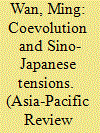

|
|
|
|
|
| Publication |
2014.
|
| Summary/Abstract |
Unlike those who blame the other side or structural forces beyond one's control for the current Sino-Japanese tensions, this paper offers a theoretical insight about the coevolution between China and Japan to explain why the two Asian great powers that had a better relationship in the past are now experiencing greater tensions when their much closer economic and people-to-people ties should facilitate greater cooperation. The two nations have coevolved over millennia with increasing intensity over time. They avoided serious tensions in the 1970s-1990s partly thanks to each being situated in a different niche. But that separation has diminished in a globalizing world and the two countries are becoming more integrated, which has triggered a backlash. The earlier generation of proponents of Sino-Japanese friendship succeeded in forging strong economic and social ties, but the current generation finds it difficult politically and psychologically to manage the new reality in their relations.
|
|
|
|
|
|
|
|
|
|
|
|
|
|
|
|
| 16 |
ID:
131596
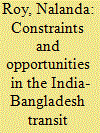

|
|
|
|
|
| Publication |
2013.
|
| Summary/Abstract |
This research note explores the transit issue that has become one of the most problematic disputes overtime between India and Bangladesh. It also analyzes its long-term implication in the bilateral relations between them. The history dates back to the pre independence period when Bangladesh and India were part of the British colony. The roads_. water and railways were then integrated in the communication system. The outlets to the sea were through Chittagong port or via the rivers of Bangladesh reaching the ports of Kolkata. India had pressed Bangladesh to provide transit facilities through the hearts of Bangladesh to connect West Bengal in the west and Tripura in the east. India claims that it will use this transit facility solely for the transport of ?eight and goods between two remotely connected parts of India. But Bangladesh has persistently denied any such agreement earing it as a threat to national security.
|
|
|
|
|
|
|
|
|
|
|
|
|
|
|
|
| 17 |
ID:
174787


|
|
|
|
|
| Summary/Abstract |
This article challenges the simplistic view that U.S. leadership in East Asia is weakening relative to China’s increasing ability to shape the regional order, which will force other states to choose between these two powers. Based on interviews with political elites, analysts, and academics in the United States, China, Japan, and Indonesia, we argue that the East Asian order transition is more complex and nuanced, especially when we examine views toward: (1) the Sino–U.S. rivalry for regional leadership; (2) whether Chinese initiatives such as the Asian Infrastructure Investment Bank and the Belt and Road Initiative disrupt the current order; and (3) the preferred vision of regional order for each of the four countries. While there is hardly a consensus view about issues of regional order, it appears that in the short to medium term, China is not expected to substantially overhaul the existing East Asian order. Nevertheless, Beijing is likely to chip away at U.S. regional leadership and, in the long term, would presumably seek to create an order that would sustain its rise and maintain its regional preponderance. The responses of other regional stakeholders toward these developments would be vital in shaping the collective impact on the East Asian order.
|
|
|
|
|
|
|
|
|
|
|
|
|
|
|
|
| 18 |
ID:
153864
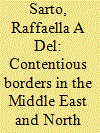

|
|
|
|
|
| Summary/Abstract |
The recent upheavals in the Middle East and North Africa (MENA) have exerted pressure on the regional state system and its borders. Exploring the altered nature and function of borders in a comprehensive and theory-informed manner, together with their domestic, regional and international implications, is long overdue. As a starting point to this endeavour, this article provides the historical context to the problem of contested borders in the MENA region since the formation of the modern state system in the region until today. While problematizing a number of key concepts, the article proposes to analyse the currently contentious nature of many MENA borders by considering the often deeply conflicting configuration of state authority, legitimacy and territoriality over time; the Arab uprisings mark the most recent of a series of critical junctures. Developments at the international, regional and domestic levels are considered while attention is paid to their intersection. The article concludes by raising the question of whether prevailing conceptualisations of the state and its borders are adequate for a real understanding of past and present developments in the region, suggesting that alternative or additional approaches may be helpful.
|
|
|
|
|
|
|
|
|
|
|
|
|
|
|
|
| 19 |
ID:
165982
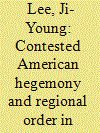

|
|
|
|
|
| Summary/Abstract |
Why did American-led postwar institution building lead to different types of security orders in Asia and Europe? The article investigates the failure of the Southeast Asia Treaty Organization (SEATO)—the only postwar multilateral security organization in the Asia-Pacific region that resembled NATO—as contrasted with NATO’s survival. Despite the popular notion of ‘American liberal hegemony’, the US-led multilateral security institution in fact faced serious resistance in Southeast Asia during the early years of the Cold War, as regional players viewed SEATO as yet another form of Western imperialism threatening their independence. The article makes a theoretical argument for the role of delegitimation in hegemonic order formation and shows that the Asian historical experience of Western colonialism had structural consequences for American-led hegemonic order building in Asia. China-India joint delegitimation strategies against the United States invoked local actors’ collective beliefs against colonialism portraying SEATO as a vehicle of Western domination. Once established, the United States’ European allies within SEATO placed constraints on the exercise of American hegemonic power, by taking advantage of the multilateral rules of SEATO and refusing to act collectively in the local crises in Laos. Archival evidence suggests that such delegitimation and restraint strategies were fairly successful in terms of limiting SEATO membership and blocking interventions in Indochina, strengthening Asian neutrality rather than creating a pro-US bloc in the region.
|
|
|
|
|
|
|
|
|
|
|
|
|
|
|
|
| 20 |
ID:
165153
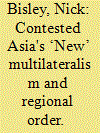

|
|
|
|
|
| Summary/Abstract |
Multilateralism has become an increasingly significant part of Asia's international relations. This paper critiques the premise that there are two phases of regional multilateralism, pre- and post-global financial crisis and instead argues that there has been one long 25-year expansion phase. Initially, this was prompted by the risks and opportunities of globalization but was adapted as a strategy to manage a changing regional order. More recently, regional multilateralism has taken on competitive characteristics reflecting Asia's more contested dynamics. The US and its allies are trying to use multilateralism as part of their broader strategy to sustain the prevailing regional order. China is also attempting to use multilateralism as a part of its efforts to change the region to one more in line with its interests and values. Multilateralism has become a sublimated form of contestation over the form and function of Asia's international order. A key consequence of this will be to weaken the policy impact of existing institutional efforts and to promote zero-sum approaches to international policy among many Asian states.
|
|
|
|
|
|
|
|
|
|
|
|
|
|
|
|
|
|
|
|
|